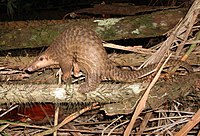
Photo from wikipedia
This study tracked and recorded the weight changes of 13 captive Sunda pangolin cubs from lactation to maturity to explored the appropriate weaning time and reveal the rules of its… Click to show full abstract
This study tracked and recorded the weight changes of 13 captive Sunda pangolin cubs from lactation to maturity to explored the appropriate weaning time and reveal the rules of its weight growth. SPSS 25.0 was used to build a cubic equation model to fit the body weight change rules of 4 individuals who nonvoluntarily ingested artificial feed (NIAF) at 127 days after birth and 5 individuals who voluntarily ingested artificial feed (VIAF) at 86–108 days after birth. The body weight of NIAF cubs aged 0–120 days and VIAF cubs aged 0–150 days were estimated according to the fitting model. An independent sample T-test was performed on the mean body weight of the two groups during the late lactation period. The results showed that at 105 days after birth, the body weight of the VIAF group was significantly higher than that of the NIAF group (P = 0.049), and the body weight of the VIAF group was extremely significantly higher than that of the NIAF group at 114 days (P = 0.008); The peak cumulative body weight of the NIAF cubs during lactation appeared around 130 days of age (n = 3); The mortality rate was 66.7% (n = 3) after about 150 days if the feed was continuously consumed nonvoluntarily. It was concluded that the milk secretion period of the mother is about 0–5 months after giving birth; the weaning period of the cubs should be 4–5 months after birth. If the cubs don’t follow the mother to eat artificial feed for 3 months after birth, it can start be induced with artificial diet which adds termites, and the time point cannot be later than 130 days, otherwise it is not conducive to the survival of the cubs; When sexually mature, the body length and body weight of female cubs account for about 84% and 60% of the adult, respectively; the body maturity and body weight of female cubs tend to be stable about 15.3 months and 16.4 months, respectively. Finally, a special needle-shaped nipples and nursing patterns of female Sunda pangolins were also recorded in this study. These findings play an important role in guiding the nursing of captive Sunda pangolin cubs and other pangolin cubs. It is expected to improve the survival rate of the cubs by exploring the appropriate weaning time and the rules of weight growth. By scientifically planning the reproductive cycle of the female Sunda pangolins, our goal is to expand the population size and eventually release to the wild, meanwhile improving knowledge of this critically endangered species.
Journal Title: PLoS ONE
Year Published: 2022
Link to full text (if available)
Share on Social Media: Sign Up to like & get
recommendations!